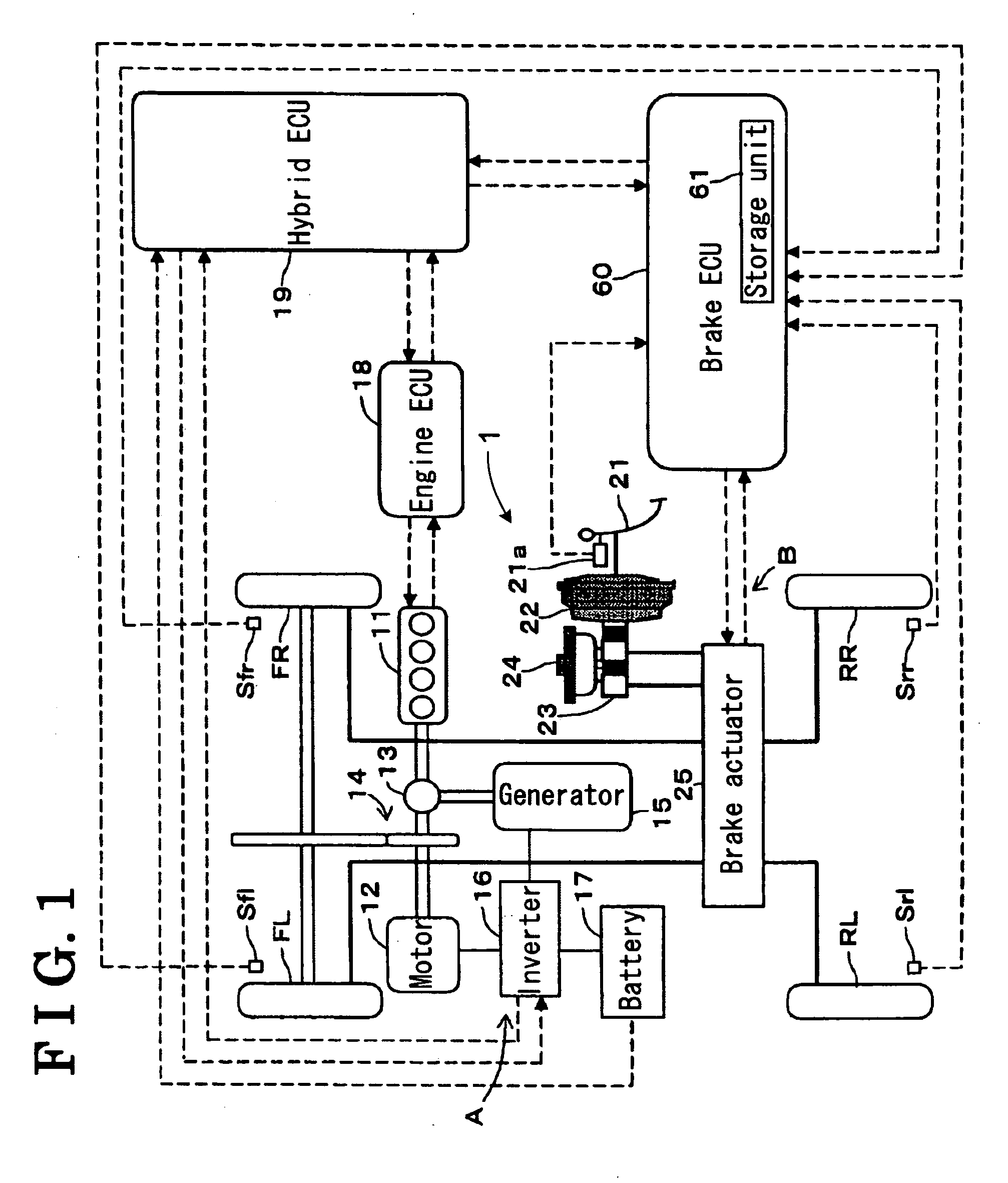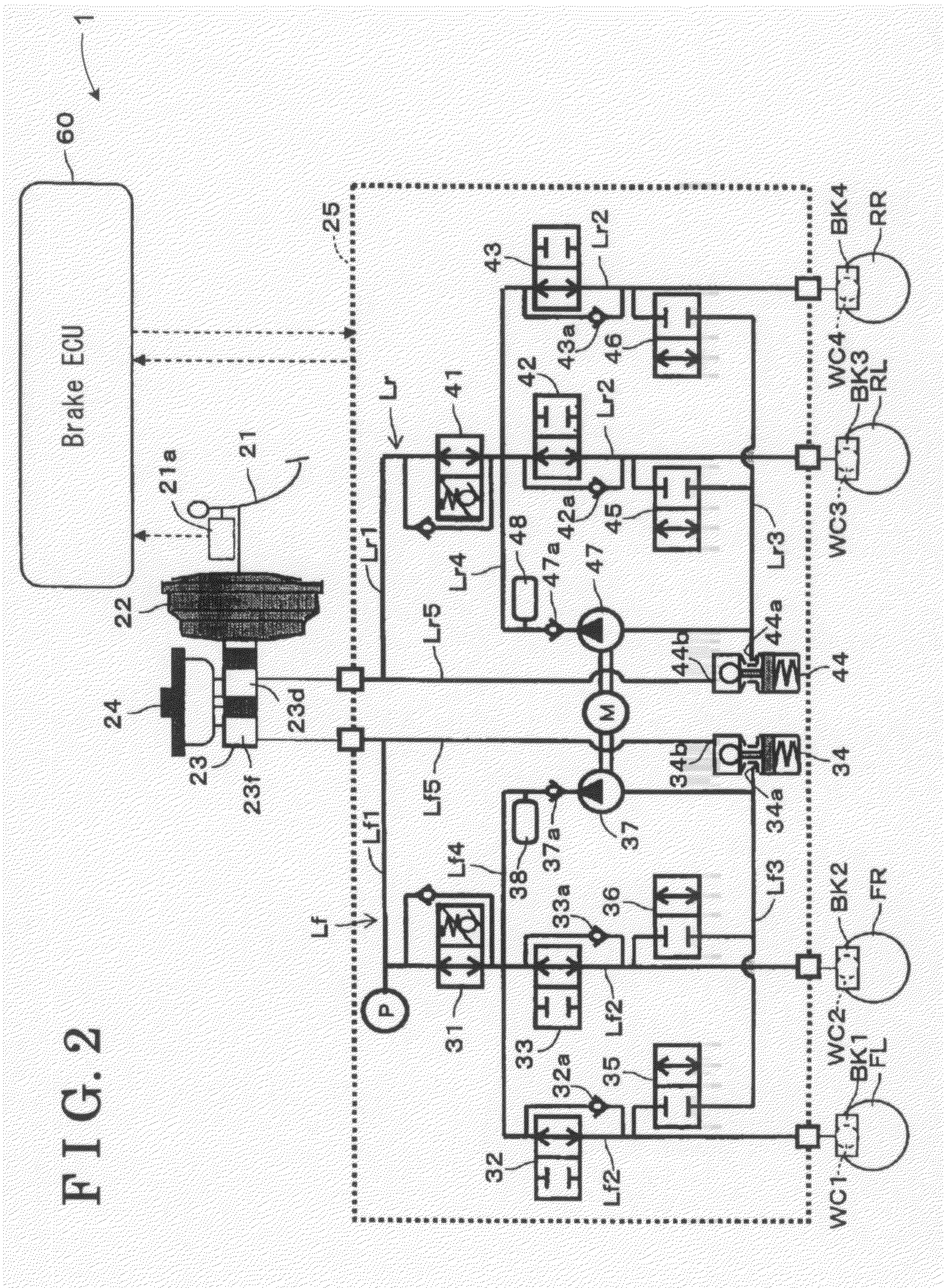Braking apparatus for vehicle
a technology for braking apparatus and vehicles, which is applied in the direction of braking systems, braking components, transportation and packaging, etc., can solve the problems of insufficient regenerative braking force in the total braking force required, the driver may have an uncomfortable feeling that the brake pedal is further depressed or lowered without his or her further action, and the driver of the vehicle may have an uncomfortable feeling that the brake pedal is depressed
- Summary
- Abstract
- Description
- Claims
- Application Information
AI Technical Summary
Benefits of technology
Problems solved by technology
Method used
Image
Examples
first embodiment
[0044]A braking apparatus for a vehicle 1 according to the present invention employed in a hybrid vehicle will be explained with reference to the attached drawings. FIG. 1 is a schematic view illustrating a structure of the hybrid vehicle. FIG. 2 is a schematic view illustrating a structure of a hydraulic brake apparatus of the hybrid vehicle. In the hybrid vehicle, driving wheels, i.e., front-left and front-right wheels FL and FR, for example, are driven by means of a hybrid system as shown in FIG. 1. The hybrid system is a power train using two types of power sources, i.e., an engine 11 and an electric motor 12, in combination. According to the present embodiment, a parallel hybrid system in which both the engine 11 and the motor 12 directly drive the wheels is used. Besides the parallel hybrid system, a series hybrid system is known, in which an electric motor drives the wheels and an engine serves as an electric power supply source to the motor.
[0045]The hybrid vehicle incorpora...
second embodiment
[0124]As shown in FIG. 12, the hydraulic brake apparatus B has a hysteresis in a correlation between the wheel cylinder pressure and the stroke of the brake pedal 21. That is, on the assumption that the amount of stroke of the brake pedal 21 is same, the wheel cylinder pressure is larger when the brake pedal 21 is depressed as compared to the wheel cylinder pressure generated when the brake pedal 21 is released.
[0125]This is because the vacuum booster 22 includes an atmospheric pressure inlet valve that is opened to move a booster output rod of the vacuum booster 22 in a forward direction when the brake pedal 21 is depressed, and a negative pressure inlet valve that is opened to move the booster output rod in a rearward direction when the brake pedal 21 is released. The opening timings between the atmospheric pressure inlet valve and the negative pressure inlet valve are different from each other and this difference achieves the hysteresis of the stroke. In addition, the master cyl...
third embodiment
[0174]An operation of the braking apparatus for a vehicle 1 will be explained with reference to FIGS. 18 to 25. Before explaining the detailed operation of the braking apparatus 1, a reason why the operation is performed will be described below.
[0175]FIG. 18 is a graph showing a correlation between a wheel cylinder pressure and an amount of stroke of a brake pedal 21. As illustrated in FIG. 18, the wheel cylinder pressure and the amount of stroke are not in a proportional relation. In a range where the stroke amount is small, an increase of the wheel cylinder pressure relative to an increase of the stroke amount is small. On the other hand, in a range where the stroke amount is large, the increase of the wheel cylinder relative to the increase of the stroke amount is large.
[0176]Thus, for example, when the stroke amount is changed from a point A to a point B as illustrated in FIG. 18 in the case of replacing the regenerative braking force with the controlled hydraulic braking force...
PUM
 Login to View More
Login to View More Abstract
Description
Claims
Application Information
 Login to View More
Login to View More - R&D
- Intellectual Property
- Life Sciences
- Materials
- Tech Scout
- Unparalleled Data Quality
- Higher Quality Content
- 60% Fewer Hallucinations
Browse by: Latest US Patents, China's latest patents, Technical Efficacy Thesaurus, Application Domain, Technology Topic, Popular Technical Reports.
© 2025 PatSnap. All rights reserved.Legal|Privacy policy|Modern Slavery Act Transparency Statement|Sitemap|About US| Contact US: help@patsnap.com



